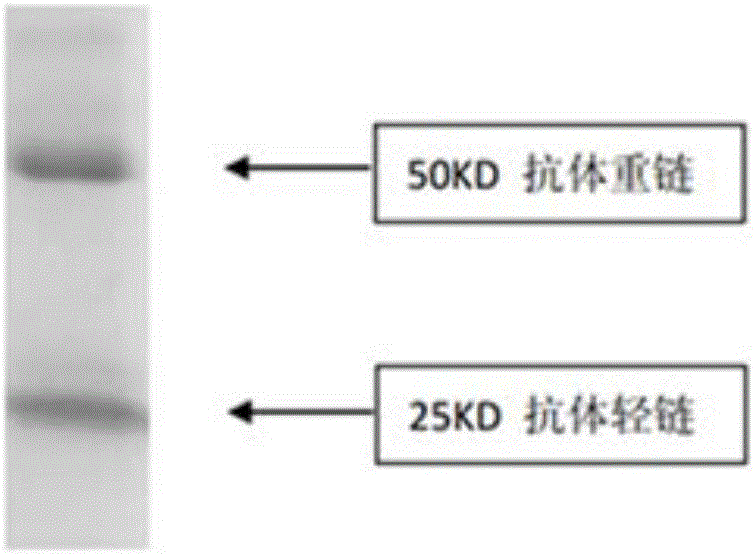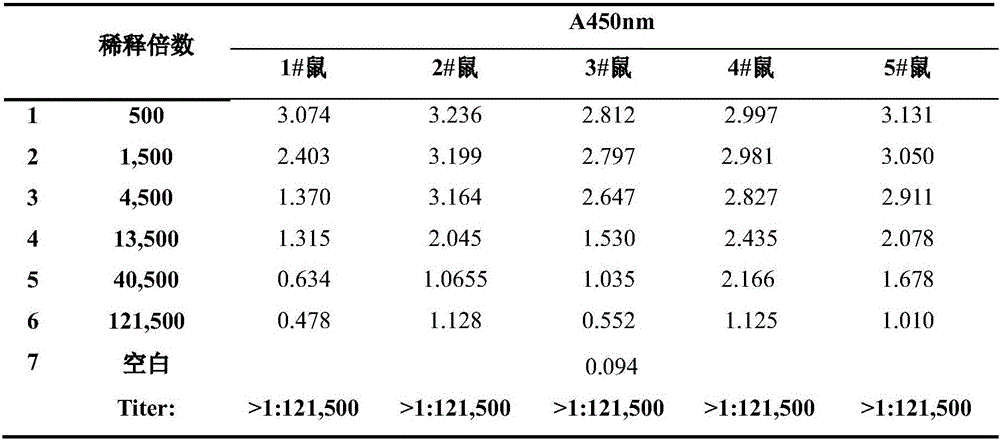Hybridoma cell strain 7G11 and antibody thereof
A hybridoma cell line, 7G11 technology, applied in the direction of antifungal/algae/lichen immunoglobulins, instruments, biochemical equipment and methods, etc., to achieve the effect of good specificity and high antibody titer
- Summary
- Abstract
- Description
- Claims
- Application Information
AI Technical Summary
Problems solved by technology
Method used
Image
Examples
Embodiment 1
[0022] Embodiment 1, animal immunization and detection of mouse serum titer after immunization
[0023] Five female BALB / c mice aged 6-8 weeks were selected and immunized with the TAO-KLH immunogen of the hapten TAO-coupled hemocyanin (KLH) and Freund's adjuvant, subcutaneously injected 100 μg, 2- Booster immunization once every 3 weeks (the first immunization immunogen is mixed with Freund's complete adjuvant, and then the immunogen is mixed with Freund's incomplete adjuvant). Among them, the hapten TAO is obtained by derivatizing Tenuaconic acid (TA) with carboxymethylhydroxylamine hemihydrochloride and then introducing the linker.
[0024] After the fourth immunization, the blood was collected for detection, and the titer of the antiserum against the TAO-BSA detection source was determined by the indirect ELISA method. The detection conditions were as follows:
[0025] Coating antigen: TAO-BSA detection source, Alternaria tennonic acid (competition antigen) produced by Alt...
Embodiment 2
[0035] Embodiment 2, cell fusion
[0036] 1. Preparation of myeloma cells
[0037] One week before fusion, SP2 / 0 cells were expanded in DMEM medium containing 10% FBS. By the time of confluence, the cells have covered about 6 bottles of T25 cell culture flasks. On the day of confluence, collect SP2 / 0 cells into a 50mL centrifuge tube and centrifuge at 1000rpm for 5min. Discard the supernatant, then add 20mL DMEM basal medium, blow off the cells and count.
[0038] 2. Splenocyte preparation
[0039] Mice whose serum ELISA titer was above 1:10000 after four immunizations were finally immunized 3 days before fusion, and 100 μg of antigen was injected intraperitoneally. Euthanize the mouse to be fused by cervical dislocation on the day of fusion. Soak in 75% alcohol for 5 min. Aseptically take the spleen, and put the spleen into a petri dish with 10 mL of DMEM basic culture inside. Remove the mesh into another dish, transfer the spleen to the mesh, and grind the spleen viscer...
Embodiment 3
[0058] Embodiment 3, fusion screening and subcloning
[0059] 1. Fusion screening
[0060] On the day before the test, coat 5 μg / mL antigen on the ELISA plate with PBS, overnight, absorb the cell supernatant 100 μL / well for ELISA test the next day. According to the ELISA results, judge the positive well (OD value of sample well / OD value of negative well ≥ 2.1 is judged as a positive well. Use a single-channel pipette to pick the positive wells detected on the entire plate, perform a second confirmation test, further confirm the positive wells, and subclone the cells in the confirmed positive wells.
[0061] 2. Subcloning
[0062] Pipette the cells in the positive wells, count them, add N / 4mL DMEM medium to the centrifuge tube, take 100μl of cell suspension into the centrifuge tube, leave 1mL after blowing, add DMEM to 4mL, blow evenly, leave 100μl (about 2 drop) at the bottom of the tube. Add DMEM to 5mL in the centrifuge tube, mix well and add dropwise to the first three r...
PUM
 Login to View More
Login to View More Abstract
Description
Claims
Application Information
 Login to View More
Login to View More - R&D
- Intellectual Property
- Life Sciences
- Materials
- Tech Scout
- Unparalleled Data Quality
- Higher Quality Content
- 60% Fewer Hallucinations
Browse by: Latest US Patents, China's latest patents, Technical Efficacy Thesaurus, Application Domain, Technology Topic, Popular Technical Reports.
© 2025 PatSnap. All rights reserved.Legal|Privacy policy|Modern Slavery Act Transparency Statement|Sitemap|About US| Contact US: help@patsnap.com



